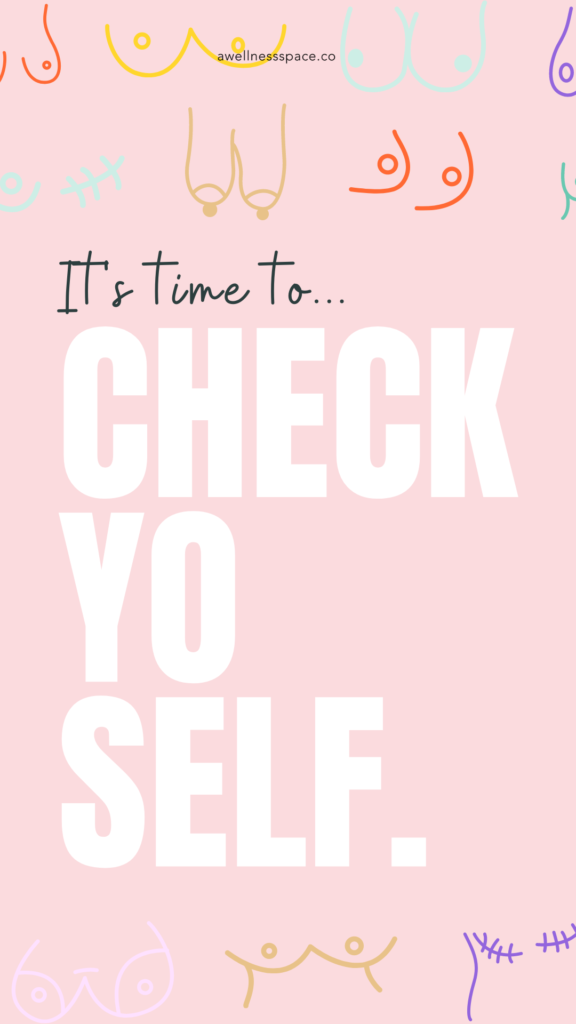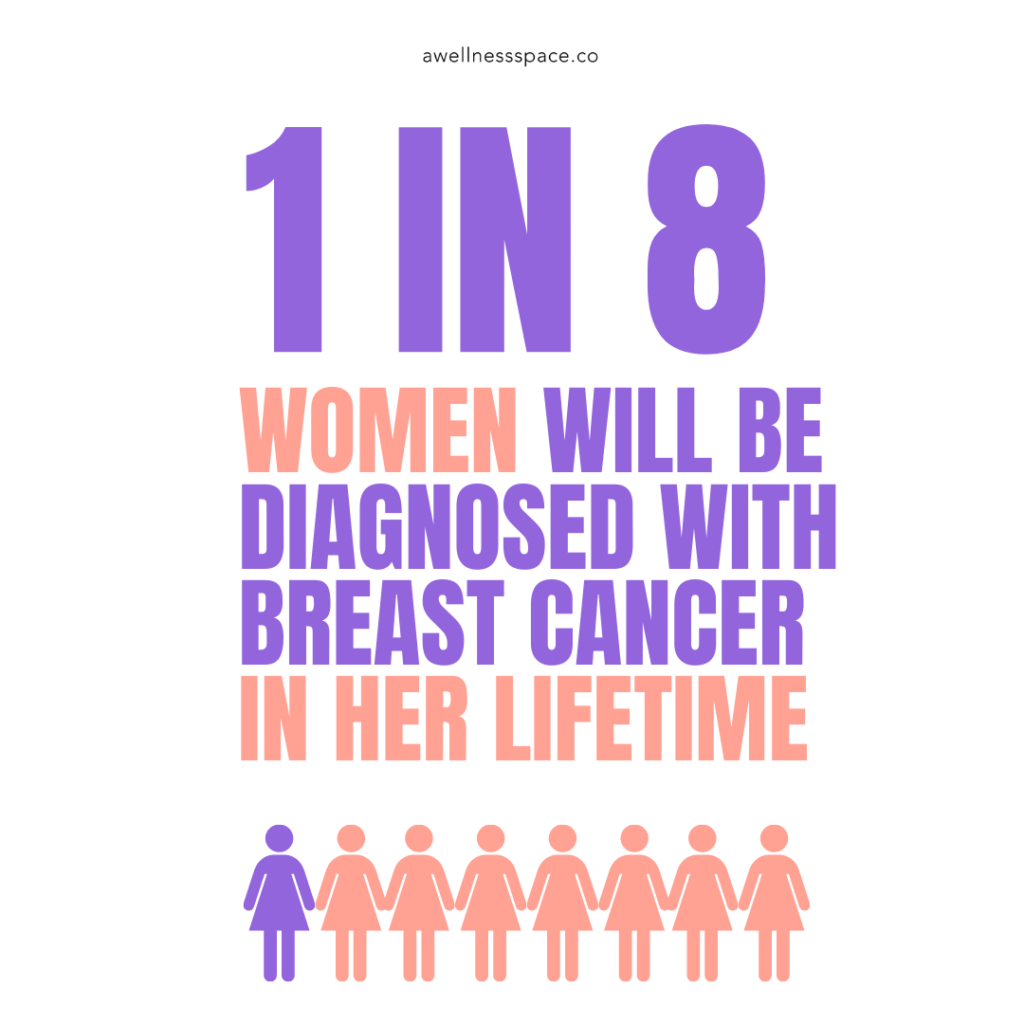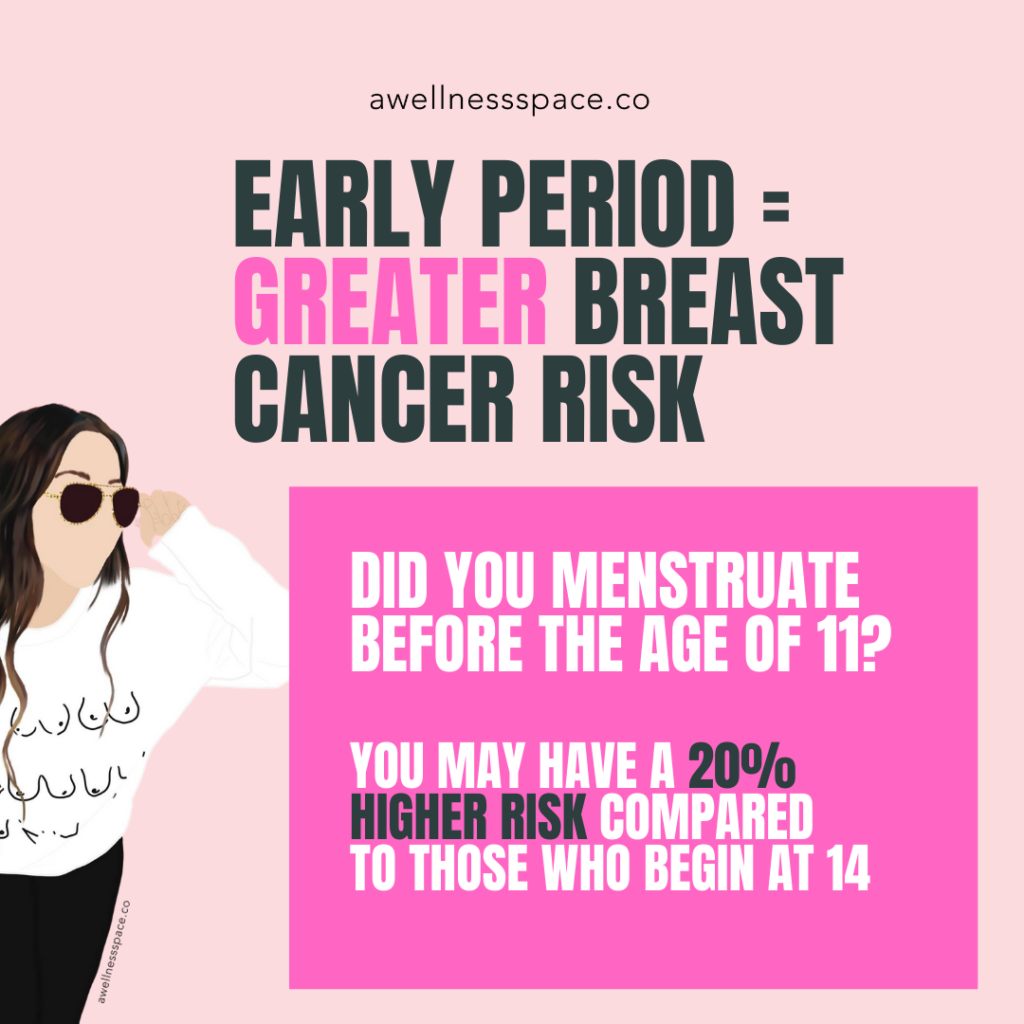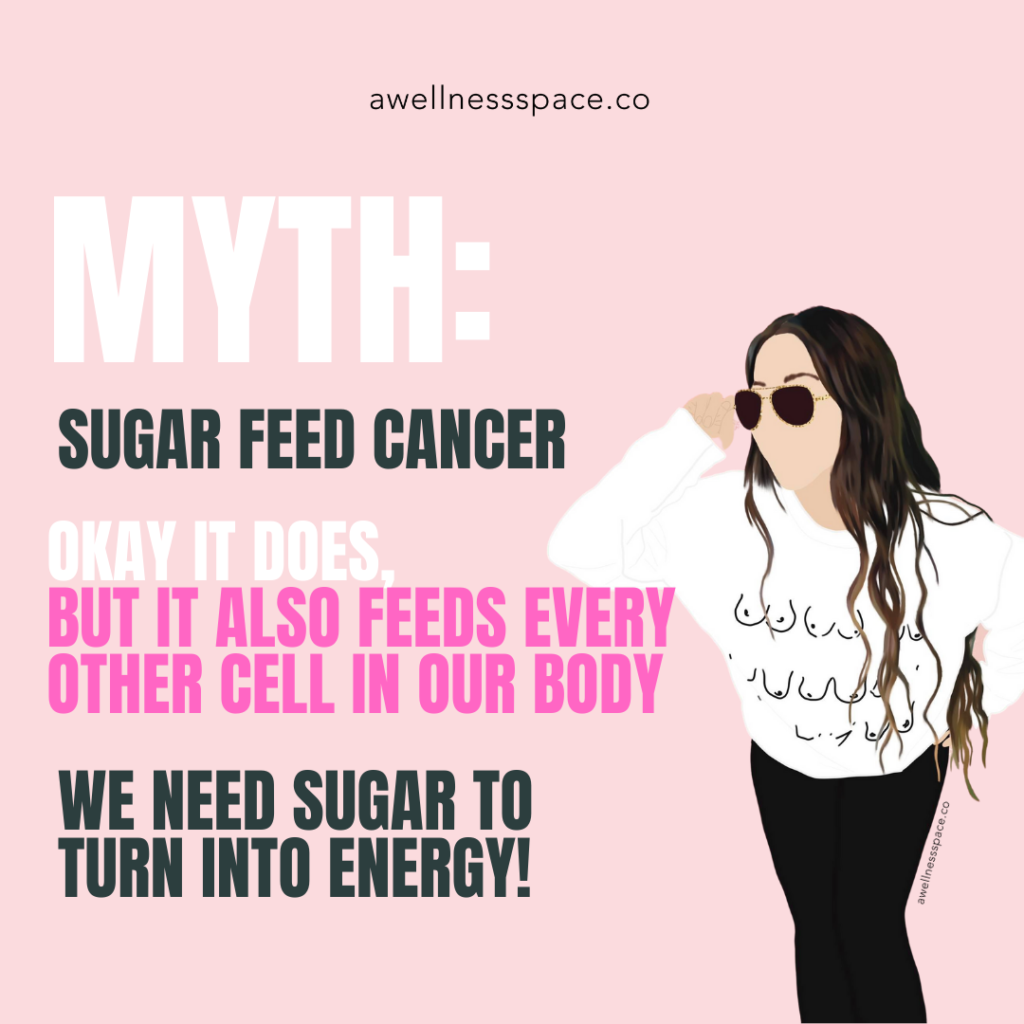31 Boob Facts for Breast Cancer Awareness
**This post contains affiliate links and a wellness space may be compensated if you make a purchase after clicking on an affiliate link. These purchases help to keep this little space on the internet up and running. Thank you!**
(• )( • ) IT’S BREAST CANCER AWARENESS MONTH! ( • )( • )
I’m giving you one BOOB fact or breast cancer fact for every day in Breast Cancer Awareness Month to help normalize cancer talk.
Check out my instagram stories for more in depth information #boobfacts!
cancer isn’t taboo
And it’s time to TALK ABOUT IT!
📢 LISTEN UP! We all know or will know someone who will be diagnosed with some form of cancer in our lifetime.
BOTH my mother and grandmother had breast cancer.
I barely knew anything about cancer at the time.
I know so much more now and am so passionate about prevention and helping others know their risks.
Cancer feels scary because it’s unknown and we usually only hear about the horror stories.
But there are plenty of good stories out there too.
There are happy endings.
There is early detection.
There are manageable forms of cancer.
So get ready for a whole lot of boob talk!
( • )( • )
31 boob facts for breast cancer awareness month
1.
feel on the 1st

Set a reminder to feel yourself up one day of the month. I usually do this on the 1st. It’s best to check your breast when you’re not menstruating because breast tissue can become larger or more painful during that time and may cause false alarms or it may be hard to feel deeper tissue.
What to watch for:
- Lumps or hard knots
- Swelling, warmth or redness
- Breast changes in size or shape
- Skin puckering or dimpling
- Itchy skin or rashes
- Nipple look and feel changes
- Nipple discharge
- Pain in one spot that doesn’t go away
- Feel yourself up! Get familiar with your breasts!
2.
1 in 8 women will be diagnosed with Breast Cancer in their lifetime

3.
3% of women diagnosed will be terminal
4.
prevention tip:
Do you consider yourself active?
Women who get regular exercise have around a 10%-20% lower risk of breast cancer compared to women who are are more sedentary.
Plus, experience a greater risk reduction the more active you are. YAY!
5.
breasts are more than fat!
For men, it’s mainly fatty tissue but did you know they also have undeveloped milk glands?
- YES, MEN CAN GET BREAST CANCER, you should do your self checks too
- Less than 1% of all breast cancers occur in men. It’s rare but it happens!
- In 2020, about 2,620 men are expected to be diagnosed with the disease
For women, it’s so much more than just fatty tissue!
- Breasts are composed of milk glands, milk ducts and supportive tissue (dense breast tissue), and fatty tissue (non-dense breast tissue).
For my non-binary folks: If you don’t know where you fall with your risks, seek out a genetics counselor or start researching at the LBGT Cancer Network. There are options for you!

6.
do you know about your risks if you have dense breasts?
How do I know if my breasts are dense?
You and your health care professional can’t tell whether you have dense breasts based on your breast shape, size, firmness or other factors.
What does it mean if you have more dense tissue than fatty tissue?
Not only do women with more supportive/dense breast tissue have an increased risk for breast cancer, and they are also more likely to have mammograms miss cancer tissue which gives them a higher risk for a late cancer diagnosis.

7.
breast implants, do they increase or decrease risk?
Neither!
No significant amount of studies have shown an impact on risk of breast cancer.
However, that doesn’t mean you’re excused from your monthly self check or annual screening.
8.
prevention tip
Research suggests that women with low levels of vitamin D have a higher risk of breast cancer. Get 15 mins of sunshine 3x a week, check with your doctor about supplementing vitamin d, and eat more mushrooms (natural source of vitamin d).
9.
are you using clean sunscreen?
Opt for a sunscreen that’s main ingredients are titanium dioxide or zinc oxide.
Stay away from: oxybenzone, octinoxate, homosalate.
10.
breast cancer rates are highest for non-Hispanic WHITE populations
Black women and white women are diagnosed with breast cancer at a similar rate, but more black women will die from their diagnosis than white women, 40% more to be exact.
So what do we do?
- Early detection is KEY. Don’t let your loved ones skip their monthly self-check.
- Don’t let them skip their annual mammograms
- Talk about risk factors with your family
- Cancer isn’t taboo. #normalizecancertalk
11.
those with a direct first-degree family member (parent, sibling, child), have an increased risk of diagnosis.
Knowing your risk is important!
If you have a family history, your insurance should cover genetic counseling so you can know your lifetime risk percentage.
We can’t control our genetics, but there are other risk factors we can control.
Hope over to Instagram and listen to my highlight: Boob Facts for Breast Cancer Awareness Month and listen to how my genetic counseling went.
12.
find a lump? It’s not always cancer!
There are multiple benign breast conditions that don’t contribute to breast cancer risks:
Breast fibrosis and cysts (fibrocystic) and mild hyperplasia, all can cause alarm when you first notice the lump.
Trust me, I’ve been there!
These are all associated with little to no increased breast cancer risk.
13.
not every cancer found in the breast is breast cancer
Did you know that not every cancer in the breast is breast cancer?
Confusing right!?
Lymphomas and sarcomas can also happen in the breast.
Lymphomas are in the lymph system and sarcomas are in soft tissue, both of which reside in or around the breast.
14.
early periods = greater risks
Were you one of the firsts to start your period in your friend group?
That may put you at increased risk.
Women who start menstruating before the age of 11, have a risk about 20% higher compared to those who begin at age 14.

15.
what about birth control
We know that hormones can take a part in Breast Cancer risks, and birth control changes our hormones, so how does that affect our risks?
Taking oral birth control (combined estrogen and progesterone) has been shown in studies to have about 20% increase in breast cancer risk.
So what happens if we stop taking oral contraceptives?
The risk disappears, not overnight, but in time. After 10 years, the risk is like you never took it in the first place.
16.
what about breast feeding?
Some of us will breastfeed, some of us won’t, but how does it affect your breast cancer risks?
Studies show that breast cancer risk can actually be reduced by 4% for mothers for every 12 months of breastfeeding. Free that nipple mamas!
17.
are there treatments for high-risk women?
YES!
Some high-risk women take may be asked to take drugs BEFORE ever being diagnosed with cancer for prevention.
Yep! It was suggested to me a few years ago…
I had just turned 30 and moved to a new state and transferred to a new cancer center for preventative care.
They took the risks assessment from my past genetic tests and suggested that I think about getting on a drug called Tamoxifen which is typically only prescribed to women who are menopausal unless you’re high risk.
Ultimately, I ending up doing additional testing and they gave me a slightly lower risk than I was given from my previous genetics counselor.
This is why a 2nd opinion is always important!
Had I agreed to take that drug prior to getting a 2nd opinion, I may have needed to freeze my eggs and start menopause at THIRTY!
What are chemoprevention drugs? Tamoxifen and Raloxifene:
In short, they basically stop some breast cancers from growing, but with cancer, nothing is guaranteed 🤷
Both come with benefits and risks, consult your physician to learn more about them if you’re high risk or post-menopausal.
18.
there are FREE help centers for those diagnosed or those who have symptoms of breast cancer
- 1-877-465-6636 from Susan Komen, talk with trained specialists and oncology social workers completely free.
- CDC’s National Breast and Cervical Cancer Early Detection Program provides breast and cervical cancer screenings plus diagnostic services to low-income, uninsured, and underinsured women across the US.
- Every Woman Counts program in California provides free breast and cervical cancer screening and diagnostic services to California’s underserved populations.
- Sliding scale screenings with Planned Parenthood
19.
one breast that’s bigger than the other?
That’s totally normal!
It’s actually less common to have perfect twins. The only time to think twice about uneven breasts are if it’s a new thing or if there are other symptoms associated with the change.
20.
myth: breast cancer is a modern disease
A 4,200-year-old skeleton from an Egyptian woman is the oldest known case of human breast cancer.
21.
cancer staging does NOT determine the patient’s survivability rate
For the longest time I thought the higher the stage of cancer meant the lower the survival rate. That is simply NOT TRUE.
The staging of breast cancer actually defines the size of the tumor and the extent of the spread of cancer.
Stage I is a tumor up to 2 cm in diameter with negative lymph nodes.
Stage II is a 2 to 5 cm tumor and positive nodes.
Stage III is a less than 5 cm tumor, which may have spread to axillary lymph nodes or the chest wall.
Stage IV is when the tumor has spread else where in the body.
22.
nubbin? Extra nipple?
Yep, they can get breast cancer too!
23.
prevention tip
Sorry girls night!
Women who have 2-3 alcoholic drinks per day have a 20% increased risk of breast cancer compared to their sober friends.
24.
Asian/Pacific Islander populations have the lowest rates of breast cancer
25.
myth: “I can’t get breast cancer because it doesn’t run in my family”
While family history is important to knowing our risks, it is NOT the only risk factor. In fact, most breast cancer is NOT hereditary.
26.
myth: “having a mammogram will cause cancer or increase my risk”
NOT TRUE!
While, yes, mammograms omit a little bit of radiation, it shouldn’t cause harm.
27.
myth: “sugar feeds cancer”
Well, yes, but also NO!
Sugar feeds every single cell in our body.
Our body turns sugar into energy in order to function properly.
In short, we actually need sugar.
Check out my Instagram post on fruit sugar and why we need it HERE.

28.
myth: “if you have BRCA1 or BRCA2 genes you will get cancer”
NOT GURANTEED!
While these genes do in fact increase your risk, it is never a guarantee.
29.
myth: “if your dr. calls you back for more testing you should be scared”
Totally NOT TRUE!
While a little anxiety inducing, this doesn’t always mean bad news.
For example,
I found a lump a few years ago and after having an ultra sound, they recommended a mammogram, and then they recommended a biopsy.
Each step of the way made me more nervous.
But in the end, all was well. No cancer here!
Do not avoid follow ups. They might actually give you a peace of mind.
30.
myth: “mammograms hurt!”
Technology has come a long way!
Mammograms are no longer crushing your breast between two heavy metal plates for what seemed like eternity.
Mammograms still compress the breast, but it is between lighter, softer material now. It’s as simple as getting your breast in position and holding you breath. Just like you do when they take an x-ray at the dentist office.
You spend more time in the waiting room than getting your actual exam.
While I can’t speak for everyone, but the little bit of discomfort is worth the 365 days of peace of mind!
31.
myth: “wearing a bra causes cancer!”
While this is talked about in the media often, there are actually no studies to back this one up.
However, I’m still personally on board to free that freaking nipple!
I personally will not be apologizing if my nipple makes anyone uncomfortable. We all have them!


